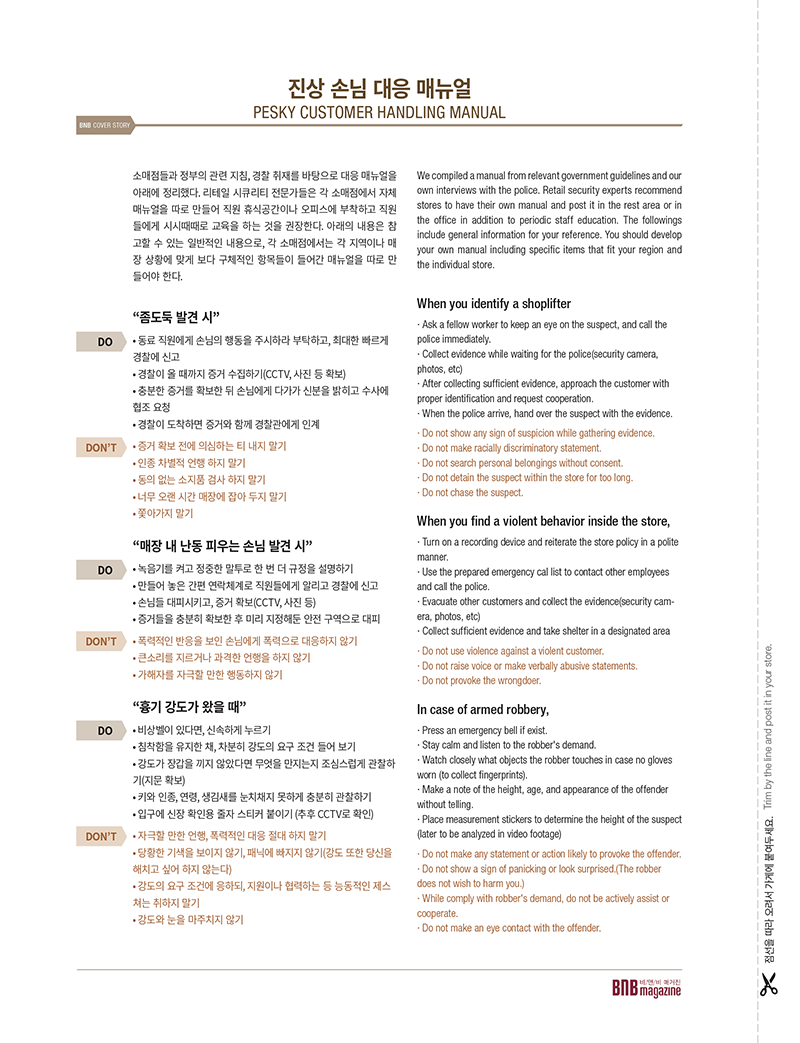How to Deal with Pesky Customers
Covid-19 pandemic and protests and riots in the midst have brought many changes. Consumers were made to use contactless shopping methods, to wear a facial covering in public places, and to interact with others while keeping social distance.
On the other hand, retail owners were made to deal with an increasing number of pesky customers. The economic crisis due to the pandemic and resultant social unrest turned a number of good customers into annoying ones. While shoplifting is on the rise, different kinds of customers make scenes for various reasons such as over mask policy and pricing.
BNB has listened to many reports from our readers about pesky customers and investigated appropriate responses, which will be discussed in this article.
PART 1 Shoplifters
One in Eleven People Is a Shoplifter. Understand Them to Prevent Shoplifting.
The National Association for Shoplifting Prevention (NASP) has reported that one in eleven people commit shoplifting. According to the NASP that collected data related to shoplifting and educated retail owners about security measures since 1995, merchandises worth more than thirteen billion dollars are shoplifted at retail stores every year. Beauty retail industry is not an exception. According to our own survey conducted while preparing this article, 3-5% of beauty supply merchandises are lost due to shoplifting by revenue.
While the loss due to shoplifting is significant, most shoplifting goes unpunished or inadequately punished. The NASP found in the same report that about 2% of shoplifters were arrested while only a half of them were charged with crime.
While 50% chance of prosecution is surprising, 2% chance of indictment is even more remarkable. If a shoplifter commits shoplifting one hundred times, he or she faces no consequence in 98 times. Shoplifters are not only hard to catch but also rarely charged of crimes, so the best response from your side is to prevent it before the crime is committed.
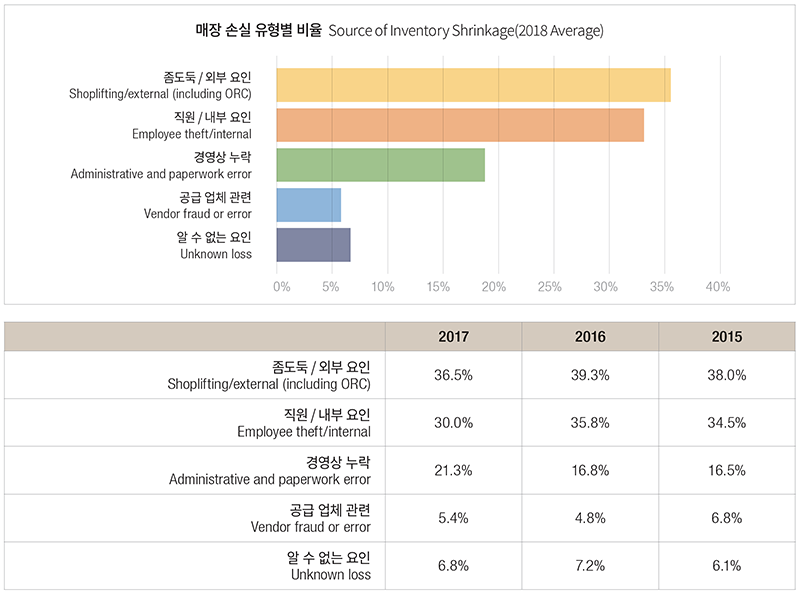
www.cdn.nrf.com / 2018 National Retail Security Survey
Be Aware of Current Trend of Shoplifting
♦ Booster Bag: a Bag Lined with Aluminum Foil
Shoplifters are using booster bags to pass the anti-theft security gate installed at the entrance. The use of a booster bag is increasingly popular as they can casually carry a bag into the store, fill the bag with merchandises with anti-theft tags untouched, and bring them home. Lined with aluminum foil, this bag can take forms of a shopping bag or a backpack, and depending on the size of the bag, a large quantity of goods can be carried at a time.
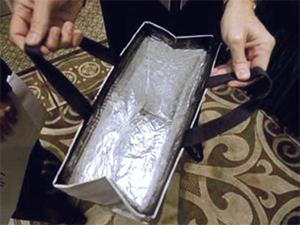
♦ Strong Magnets to Remove Tags
Anti-theft stickers and labels can be tempered with strong magnets to destroy the anti-theft capability. You can easily purchase magnets strong enough to kill the alarm triggers of various tags. Thieves locate security cameras and use their magnets they brought with them to disable the alarming capability of anti-theft tags. When the alarming function is disabled, it would be hard to prove an item is stolen, not to mention that you have no legitimate cause to request a search of suspect’s personal items.
♦ 2-Person Act
It is the most classic and common method. This act is commonly used by professional thieves, so when you witness one, you are better off to see it all the way to the rightful punishment. One of the team would create diversion by faking theft or arguing with a staff member while the other commits crime. Sometimes, a number of people would cause a scene by making noise or falling on the floor to free others to commit theft.
How to Prevent Shoplifting
♦ Appear as a Heavily Guarded/Secured Store
The top reason that police departments prefer hiring a bigger officer is prevention. While their bigger size can be useful to subdue violent criminals by force, it is more of the show to discourage violence in advance.
Atlanta Police in a recent interview with BNB Magazine explained that the same principal can be applied to shoplifting. A store that had fewer blinder spots; was better prepared against shoplifting; and reported shoplifting more frequently often reported fewer incidents overall.
Anthony W. Grant with Atlanta Police says investment in anti-theft security system and higher rates of reporting can prevent shoplifting. As such, retail owners should invest in security system, report incidents to the police, and complete a report however petty the loss was.
“The best way is a vigilant reporting of incidents. The more report you make, the more shoplifting go punished. As a result, shoplifting is discouraged. The involvement of police itself can have a preventative effect. If you have a big concern of loss due to shoplifting, you should invest in security cameras. They are very effective and realistic preventative measures. In fact, we often find evidence in camera footages and use it to identify and investigate suspects. Retail owners should regularly check if the security system is working, and they should call the police no matter how small the loss due to theft was.”
♦ Install Security Cameras Effectively
Then, how should you install cameras in order to prevent shoplifting? The most important evidence in catching a shoplifter is the face of the offender and the license plate of his or her car. If you have both, catching the offender gets much easier. Kiwon Lee, CEO of security company NEOX United, wants to inform BNB readers how to install cameras to record the face and license plates.
- The Position of Camera to Capture Shoplifter’s Face
To obtain the identifiable facial image, you should pay attention to the security camera at the entrance. If the camera points toward the outside of the store, the person entering gets backlighting and his or her face becomes unidentifiable. An easy fix is to face the camera inwardly to capture the face of existing customers. In addition, you should place the camera not too high but about the eye level. It also gives notice to the potential criminals to discourage any criminal act. - The Position of Camera to Capture Shoplifter’s License Plate
To obtain an identifiable image of license plates, you should install cameras at the entrance of parking lot. It would be impossible to cover the entirety of parked cars, so the cameras should be placed in the gateway. If you place a zoom camera pointing toward the parking lot entrance, you can record all the vehicles entering the parking lot. - As to the Camera System, “No Need to Fixate on High Resolution.”
Many beauty supply owners nowadays look for the highest possible resolution—9MP. However, high resolution means you can maintain three to five days of recording at most in a 4TB storage drive. To have your record go back further—a month at the minimum—you should opt for 2MP cameras. 2MP cameras are sufficient to capture recognizable faces and license plate numbers.
♦ Use of Anti-theft Pins and Sticker Tags
You can physically attach an anti-theft tag to a good and remove during checkout for paying customers. Any remaining tag causes an alarm to go off when sensed by the antenna installed at the entrance. Generally, on an expensive or bulky item, you place a noticeable and sturdy tags such as pin-types, and on a smaller item, you place corresponding sizes of stickers.
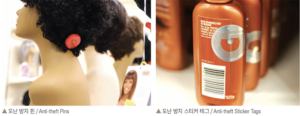
[Editor’s Pick] Tags for Eye Pencils and Lipsticks
Beauty supplies often suffer substantial loss due to theft for smaller cosmetic items. An anti-theft sticker sensor product is available in sizes that fit small and thin goods such as lipsticks and eyeliner pencils. This U.S. patent pending product is available from ZONETECH.
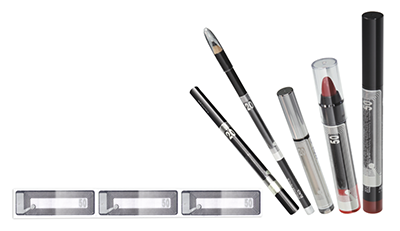
ZONETECH’s U.S. patent pending sensor tag that can be easily attached to pencil-shaped goods.
♦ Reduce the False Alarms by Paying Attention to the Edges.
Even after processed at checkout register, a alarm often goes off at the entrance. This is not just embarrassing to the customer but also to the retailer.
CEO Bongjin Yim of ZONETECH, a security company specialized in anti-theft, points his finger at the improperly removed sticker labels.
“The main culprit is the remaining capability of the sticker label after a checkout. You need to disable the capability properly using the strong electromagnetic field produced by a flat panel of a provided device. The strongest electromagnetic field resides on the edges of the panel. Therefore, you should glide the tag from one edge to another like you’re combing, which should prevent any false alarm.”

♦ Placement of Security Officers
Some retail stores hire active duty police officers as security guards. A number of retail stores interviewed by the BNB spoke highly of the placement of security officers, acknowledging the boost of perception of security and the real-life impact. They are available for hire at $25/h on average. The security guards wearing law enforcement uniforms not only create a sense of security but also increases the wariness of potential shoplifters. They can protect the customers and employees when an incident happens, and in addition, they perform a search of personal belongings when an alarm goes off. If the cost is troublesome, you can hire them only for certain hours. Just giving the image of security guards to shoplifters from time to time, you can generate sufficient effect.
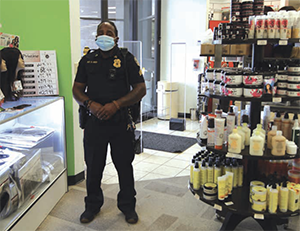
A beauty supply store in the Southwest with a law enforcement officer posted at the entrance.
♦ Get a Second Opinion about Your Trust—Anti-theft through POS
At times, a group of employees may conspire with shoplifters. They would plan together with shoplifters and call them during their shifts to assist the theft. To prevent such unfortunate events, many POS providers integrated various anti-theft functions into the system. Golden Key POS, a POS distributor for beauty supply retailers, explains three features in its POS system you can utilize against theft.
- Different Role/Authorities per Individual Employee
You can set up individual staff account for each employee and give a set of authorities such as void, refund, and discount according to their role.
- Synchronizing security cameras and POS
You can collect evidence of sales, theft, and attempted theft by synchronizing security cameras with the POS to display the information about the product scanned on the monitor real-time.
- Email/Text Alerts
You can receive an alarm via email or text upon certain triggering events such as when an employee opens the cash register without recording a sale, activates payout—withdrawing cash from the drawer, processes a return, manually inputs reward points, or voids a transaction.
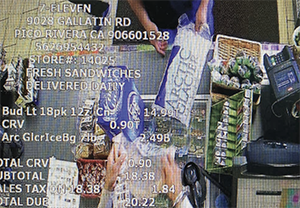
The display of text-based checkout information over camera footages. (Courtesy of Golden Key POS)
What to Do to Punish Shoplifters after Catching Them
If you have a proven record of having shoplifters subject to criminal penalties, you can boost your anti-theft security. This sort of news spread quickly in the neighborhood, and you can be recognized as a store that is tough on theft. The path is nevertheless not an easy one. As mentioned above, shoplifting is not only hard to catch but hard to punish. Regardless, if you want the justice, you should know what to do in detail.
The path to criminal justice is as follows:
- You should learn the laws of your state.
- Secure the evidence and call the police.
- You should seek cooperation from a suspect.
- You should keep your eyes on the suspect until the police arrive.
The definition of theft varies from state to state; you should know your state law.
The definition of theft varies widely. Some states have too lenient of an approach while others too strict. The opposite ends of the scale is discussed here for an example—Oklahoma and New York. In Oklahoma, you commit theft when you bring the stolen goods outside the store. Even if the criminal intent is clear, as long as you are still inside the perimeter, you have not committed the crime. On the other hand, in New York, an attempt to hide merchandise can constitute theft. As soon as a suspect hides a good in a bag or in the pocket, the suspects can be regarded as a thief.
If you secured security camera evidence and others, call the police and seek cooperation from the customer.
If you have a witness or footage of criminal behaviors, you should first call the police and gently approach the customer to explain the situation. You should disclose that you have evidence and explain the benefits of cooperation and possible consequences if refused to cooperate. You should obtain consent to search the customer’s belongings and identify stolen goods. The important step is to get consent before you search any personal belongings. If you conduct a search without consent, you can get later sued for battery or assault in reverse. If cooperation in unlikely, you should not push too hard because you can press charges based on other evidences than actual goods.
You should gently and kindly approach the customer to prevent the customer leaving the premise before the police.
Even if you call the police right away, a police response will be delayed quite often. You should hide the fact that you called the police to calm the customer and keep him or her in the premise. You can invite the customer to an office to make conversation and distract. (In many cases, the customer would simply run away in this step.) If you hold the customer for a unreasonably long time period, false imprisonment charge may be brought against you. So, be expedient. When the police arrives, you should hand the customer over with other evidences.
Be cautious throughout the process.
A careless action may bring about unexpected harm. If you bring up suspicion without a reasonable cause, you can be punished for racial discrimination. Any search without consent is considered assault. It is a crime of false imprisonment if you detain a customer in your store for too long. Most shoplifters are experienced with the process, so they can be quite clever. If they realize that they are suspected, they can quickly dispose any stolen goods and pretend innocent or they might argue they were returning the items. Unless you can prove otherwise, your action may bring opposite effects, so you should simply be watchful of any behavior of the customer until the police arrive.
PART 2 Violent Customers in Retail Stores
“Retail jobs without proper precautions as to robbery, riots, and violence may face higher risk than other workplaces.”
According to the statistics released by the U.S. Department of Labor in December 2019, retail workers account for more than 10% of death in workplace. Despite being a less dangerous workplace, retail spaces face higher risk of death of employee because of a few circumstances exposing their employees to risks according to the DOL. As they face a number of random strangers every day, workplace safety is very important, the DOL explained.
Furthermore, the number of scuffles due to a request to wear a mask or an argument over price between the employee and the customer increased since COVID-19. If you want to deal with disorderly conducts and prevent any unfortunate event, you should look up preventative measures recommended by the government and learn what can be done and what cannot.
Government Guidelines for Preventing Accidents
In response to many incident reports in relation to the retail COVID-19 policies, the Centers for Disease Control announced the guideline to prevent accidents on September 1, 2020. Retail storeowners should follow and implement all of the following nine items in the guideline recommended by the government to prevent violent customer behaviors.
- If possible, promote non-contact transactions (curbside pick-ups, personal shoppers, spreading shopping hours).
- Publicize store mask policy, social distancing measures, and limits on number of shoppers allowed at a time as widely as possible.
- Announce COVID-19 policies on your business website.
- Conduct employee education on apprehending risks, ways of dispute resolution, and non-violent responses.
- Set forth procedures to evaluate and respond to workplace violence. Create an emergency contact list to call on-duty managers or on-site supervisors or call the police.
- In case of threat or violent situations, you should do your best to prevent employees and customers from harm.
- If possible, do not leave an employee alone in the store. You need at least a two-person team.
- Educate employees about the security system including cameras, alarms, and emergency buttons as well as how to deploy them.
- Designate a safe room (that can be locked from inside and have an emergency exit) where employee can seek shelter in case of emergency.
Handle It in a Way that Reduces Harm to the Store
There are occasions where you cannot suppress your anger. Although you learned preventative measures and completed relevant courses, you may reach a certain detonating point facing an outrageously unreasonable situation. If you get involved in violence, how do you take care of it afterwards?
Consult a lawyer
Although the responsibility of violence often falls on both parties, if the other party is clever enough, you might come out as solely responsible. Before you cooperate with the criminal investigation and choose your store’s official stance, you should consult an attorney first.
Resorting to Social Media
Though you want to avoid making it public, if there is no other way, you should act fast. If you have an official business account, you can explain the situation with objective factual evidences. More often than not, you might be in trouble because of unfairly edited video clips. If you want to turn the table, you should respond with a full version of the story with video containing what led to the violence.
However, you should focus on protecting your reputation but not on excuses or complaints. If you have made racial statements or acted in such ways, you should admit your fault and apologize. Preferably, you should display an effort to prevent reoccurrence in the future.
Store Owners’ Tips to Deal with Pesky Customers and Shoplifters
“Act politely even more and actively talk to them”
I use a different approach when I deal with a male and female customer. If you’re dealing with a male customer, you make simple statements but address them politely. When you’re dealing with a female customer, you should greet them the moment they enter the store. If there is suspicion, you rather make more conversation. You want to keep them occupied. If you are certain that a theft occurred, you make a firm statement. -East coast Business Owner in her 40s
“When you catch a shoplifter, you should separate the person and the goods.”
Shoplifters often incur more psychological damages than financial damages. It just feels very wrong. So, you often cannot manage your anger and make things worse. Once I chased the shoplifter to her car and yelled at her while pounding the vehicle. Now I regret what I did. It’s often petty theft, making the police very reluctant to follow through, and even if you go to the trial, you expect to attend the court proceeding three to four times during business hours. Prevention is the key indeed. If an alarm goes off from the entrance, you need to first separate the person and the goods. You should explain that there must be some sensors left out on an item and ask to hand over the bag. If you find any sensors not removed by mistake, apologize for it, remove the sensor and return the bag. -West coast Store Owner in his 60s
“I tell employees never to chase a thief.”
There was an occasion where an employee followed a thief and caused a big trouble. Afterwards, I tell them never chase them. The safety of employees is the priority during theft incidents. Instead, we swiftly review security camera footage and call the police. You can’t help if the suspect runs away meanwhile though. -30 something Store Manager in the Southeast
“I try to convert a shoplifter to a regular customer.”
Whenever she caught a petty theft, my mom would give away the goods but warn there must not be a second time. When she does, many of them come back as regular customers. – 30 something Store Owner in Midwest
“Though I call the police every time, I let them go most of the time.”
When we catch a shoplifter, we automatically report to the police. When asked if we want to press charges, I usually say no as long as it is petty. -50 something Manager in the Southeast
Click here to download the printable “Pesky Customer Handling Manual”
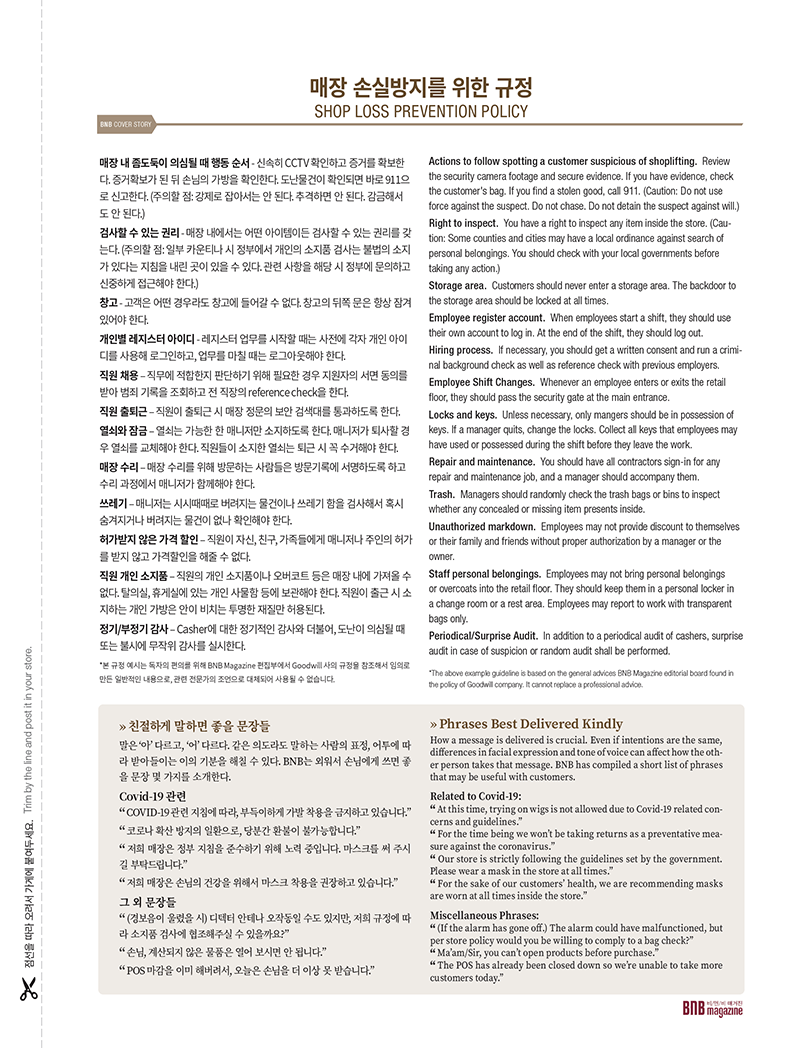
Click here to download the printable “Shop Loss Prevention Policy”
